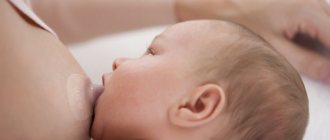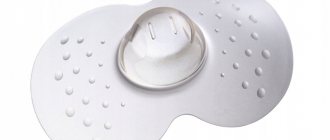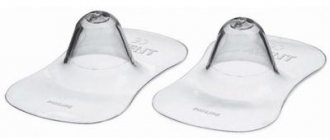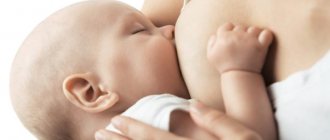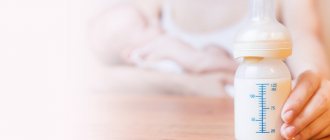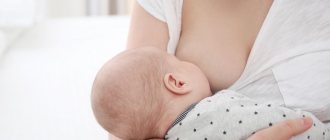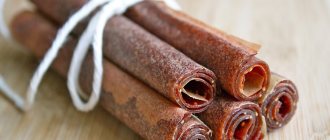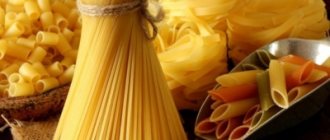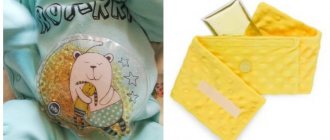When might you need breastfeeding pads?
Breast shields for feeding should be used as a last resort because some problems may arise after using such devices.
Before a mother tries to feed her baby using pads, she should consult with a breastfeeding specialist. Mom may experience painful sensations in the nipple area during feeding, but using attachments will not eliminate these symptoms. Unpleasant symptoms during breastfeeding can worry many mothers. This is due to the fact that the skin of the nipple in the initial period is very tender and vulnerable. But then, with regular feeding, the skin thickens and the pain goes away.
Situations in which breastfeeding pads are essential
There are situations when breastfeeding problems can only be solved by using breast pads. Indications for the use of special devices can be from both the baby and the mother. Prematurity and pathology of the central nervous system are the main problems that can interfere with the normal course of natural feeding.
Children born prematurely are weakened and cannot independently carry out the full act of sucking. They also often latch onto the nipple incorrectly, so special shields help maintain breastfeeding.
Indications from the mother include problems related directly to the nipple. On the first day of feeding, a woman’s nipples have rather delicate skin, which can be easily injured when sucking, even to the point of cracking. In such a situation, painful sensations appear that bring quite significant discomfort. During this period, it is recommended to temporarily feed the child through pads and treat damage to the nipples with healing creams and ointments, for example, Bepanten.
Also, a woman may have anatomical features of the structure of the nipple; it can be either flat or retracted inward. Both options make feeding difficult. In this situation, the breast shield stretches the nipple, and the baby can eat without worry.
Contraindications for using pads
There are no strict contraindications to the use of pads. But it must be remembered that the use of these devices should be temporary, as some problems may arise after their use. Lactation may decrease because the baby cannot suck effectively through the pads. As a result, the baby may not gain weight well. The learning process is also difficult. The baby gets used to eating through the pad, so without it the baby may not latch onto the breast.
Pros and cons of using overlays
Firstly, through the breast pads the breasts are less stimulated, and accordingly the amount of milk decreases, which can lead to underweight in the baby. Also, the child may swallow a lot of air, which leads to regurgitation. Lactostasis is possible, since it is more difficult for the child to fully empty the breast through the pads. And also when sucking, the baby feels like a pacifier. Another unpleasant aspect of using pads is the need to sterilize them before each feeding.
Very often the use of overlays is not justified. For example, if your mother has flat or inverted nipples, you should not use breast shields. Since they can provoke breast refusal. Nipples of any shape are suitable for feeding, since the baby does not suck on the nipple. The nipple is just a guide. Mom needs to learn how to insert her breasts as deeply as possible. At first, the baby may slip and release the breast a little, but, as a rule, within a month he adapts to sucking properly.
Using pads during the healing period of cracks is also not very convenient, since even through the pad a child can also injure the nipple. The optimal solution in this situation should be to correct the attachment and select a position in which friction would be minimal.
Main types of accessories
Breast pads for feeding differ in the material from which they are made.
There are 3 main types of accessories.
Moreover, the first two types are more of historical significance.
- Rubber pads are a nipple with a glass or plastic base. Doctors and breastfeeding specialists do not recommend using this device, since rubber attachments have a large number of disadvantages. Firstly , with this design, a distance is formed between the mother’s nipple and the child. As a result, milk stimulation does not occur. Secondly , the rubber pad does not fit tightly to the chest. Therefore, milk may leak past the baby’s mouth. Thirdly , there is no skin-to-skin contact between mother and child, which is of great psychological importance.
- Latex nozzles are also practically not tried on at present. Just like latex nipples, it is not recommended to use them, because children often experience allergic reactions to this material. Latex nozzles have an unpleasant odor, and they also quickly become unusable.
- Silicone nursing pads are the most popular today and are also safe. The material the nozzle is made of is thin, transparent, hypoallergenic. Due to the fact that the silicone nozzle fits tightly around the nipple, it is easier for the baby to grasp the nipple with the areola and, thereby, stimulate milk production. Moreover, the child can feel the mother's warmth and close contact is achieved. Silicone material is highly wear-resistant, does not lose its original appearance, and also tolerates boiling well during processing.
Instructions for use
Since it’s one of the best, let’s look at how to use Avent silicone feeding pads. User manual:
- The first step is to clean the lining from various bacteria. Sterilization is a very important step, don't skip it.
- The next step is to put on the pad. To do this, excite the nipple, turn the product inside out, then, applying it to the nipple, turn it back according to the shape of the breast. You need to make sure that the pad fits snugly on your chest.
- You can moisten it a little with warm water, so there will be less air between the chest and the pad, and it, like a suction cup, will sit more firmly on the chest.
- If the baby does not want to take it, you can literally add a couple of drops of milk to its tip.
- The baby's nose should not rest against the pad, so place it so that the edge with the cutout is opposite the baby, and not to the side.
- The process of feeding the baby and the sucking mechanism should be identical with and without the pad.
Recommendations for use
In order for the attachments to fully perform their functions, it is important to use these devices correctly and know the general recommendations for caring for the product.
How to choose the right size?
It's no secret that every person is individual.
Therefore, nipple shields should also be of different sizes in order to fit tightly to the breast. It is very difficult to immediately decide on the size. After all, the nozzle must fit both the diameter and shape of the nipple. Therefore, mothers often have to take several sizes and preferably from different manufacturers in order to try at home and choose what suits mother and baby. Also, the size must be suitable for the child. For example, for premature babies, it is recommended to use a small nipple so that the baby can fully latch onto the nipple. Medela provides this nipple nipple diameter of less than 1 cm in size S.
It is important to pay attention to the number of holes in the nozzle; the flow and amount of milk that the baby will receive depends on this. The sizing chart of most manufacturers is based on the diameter of the nipple. Basically, modern companies offer the consumer 2 main options, which are as close as possible to natural sizes. The small size or M fits nipples with a diameter of about 10 mm, and the larger size or L fits nipples up to 20 mm in diameter. Some manufacturers make universal silicone breast pads.
How to properly attach a baby?
Before you put your baby to the breast, you need to know how to put on nipple shields correctly.
Each time before use, it is necessary to disinfect the devices by steam treatment.
Before dressing, you need to make sure that the nipple is tense. In the same condition, you need to measure the diameter of the nipple before purchasing the device. The pad is turned out and firmly attached to the skin of the chest. To make putting on easier, it is recommended to put on the device while wet. The baby's nose should be located in the middle, resulting in a “butterfly”. The mother needs to try to ensure that the baby captures the entire nipple along with the areola. With the pad positioned correctly, the woman will feel a surge of milk. What position the baby will lie in during feeding is up to the mother to decide. After all, for some it is more convenient to feed while lying down, and for others while sitting.
Product care
Since breast milk is a favorable environment for the proliferation of pathogenic bacteria, you need to carefully monitor the cleanliness of products. The first thing you need to do after purchasing breast pads is boil them. Each feeding through the device should end with washing the device in a soapy solution.
Dry pads are stored in special containers. It is not recommended to boil each time before use, as the silicone material may not be as soft as it was at the beginning. It is best to process the pads in special steam sterilizers. Steam treatment is the most gentle for silicone products.
Features of choice
First of all, decide on the size. This is quite an important stage. Which company to choose is up to you. According to reviews, the Avent feeding pads are one of the best. But the ideal option in this situation is the opportunity to try on different sizes from different manufacturers. This way you can select the required overlay with maximum accuracy. When trying on, remember that the nipple should be taut. For premature babies, smaller pads than standard ones are chosen, but they still need to be tried on.
Remember, the highest quality and safest material for overlays today is silicone. Latex and rubber are the worst choices; they cause allergies in both babies and mothers. Silicone will give you a feeling of lightness, and you will completely forget that the pad is on you.
All the advantages and disadvantages of breast pads
Before choosing to feed your baby through breast pads, you need to highlight all the pros and cons of this device.
Of course, breast pads are a useful invention that has many advantages:
- pads protect the breasts from mechanical damage that can form during feeding;
- overlays allow you to continue breastfeeding even with existing cracks in the nipples;
- nipple shields can shape the nipple due to anatomical conditions that may interfere with breastfeeding;
- Even premature babies and children with pathologies of the central nervous system can receive mother's milk without problems naturally using pads.
Mom also needs to familiarize herself with the existing disadvantages of this product:
- Over time, babies get used to feeding through breastfeeding and may not take the “bare” breast in the future;
- Feeding through pads does not fully replace the natural process. As a result, incomplete emptying of the breast and the formation of lactostasis may occur;
- Some mothers may have difficulty putting on the pads. And also this process is practically impossible outside the home;
- an incorrectly selected breast pad can provoke the development of hypogalactia (decreased milk supply).
It is recommended that you consult with a lactation specialist before purchasing breast shields.
How to refuse a device?
When making a choice in favor of pads, you need to remember that sooner or later it will be necessary to completely stop using them. If this is easy for you to do, then for the baby it is not at all. And you need to know how to do this, just like you need to know how to use feeding pads (Avent, Medela, etc.). This is quite important information that stands on par with the instructions for use:
- During feedings, when you use the shield, try to remove it as quickly and carefully as possible. If the baby is hungry enough, and you do everything carefully and quickly, then he may not even notice that he is already eating without the help of a silicone product.
- Just try feeding him without the pad. Just do it a little smarter, choose a time when the child is still sleepy and will not be able to fully assess the situation.
- Gradually, in small but sure pieces, cut off the silicone pad. With each feeding it should become less and less. And when only the hole for the nipple remains, throw it away and feel free to try feeding without anything.
- Weaning off pads can take a week or even two. Therefore, it is necessary to be patient, and also, if possible, hide all the things that the baby likes to suck, increase tactile contact between mother and child, and, if everything is bad, encourage the baby. If he refuses, feed your baby with a bottle, cup, or pipette and then breastfeed.
This knowledge will help you equip yourself with everything you need to deal with your child’s whims and difficulties in terms of feeding.
Top 5 best breast pads
Currently, there are 5 most popular breast pads on the market today, which are in demand among most mothers.
- Philips Avent silicone pads. This brand is the most purchased. The manufacturer offers a large number of devices (pacifiers, bottles, sterilizer, pads, etc.) that help the mother. Breastfeeding pads are made of silicone material, which is tasteless and odorless, and also retains its original appearance for a long time. Some packages may include 2 sizes at once, which is an undeniable advantage, since it is more convenient for mom to choose her individual size. The small version of the product is designed for a nipple diameter in a tense state of no more than 10 mm, and the larger size is suitable for a diameter of up to 20 mm. The price of overlays, regardless of size, is 550 rubles.
- Medela silicone pads are also made from thin, safe silicone material. The advantage of this brand is the production of the smallest pads for premature babies. The size chart of the overlays includes options M and L. M is suitable for a nipple diameter of 10 mm, L is designed for a nipple size of more than 10 mm. In addition to the pads, the packaging includes a special container for storing the product. This set costs about 500 rubles.
- Pigeon silicone pads. Such products contain delicate, thin material that does not cause allergic reactions in the child. The package also includes a container, which is very convenient for use. The manufacturer offers more accurate dimensions. M is designed for a nipple diameter of 11 mm, and L for 13 mm. The price category is not much different from the above-mentioned companies and is approximately 500 rubles.
- NUK silicone pads. The devices are made of the same hypoallergenic, thin silicone. The pads are also available with a protective container. Sizes provided are for larger nipples. Size M is suitable for a nipple diameter of 20 mm, and L for 24 mm. NUK brand pads have a unique triangular shape and soft ridges on the base to stimulate milk. The price for a set starts from 360 rubles.
- In the last paragraph, you can indicate several manufacturers, since they are less popular and have a universal size. These include Ameda, Chicco, Tommee Tippee. The price varies from 350 to 500 rubles. The composition differs little from each other. All pads have soft, delicate, thin silicone material.
Breast pads
Rules for using pestis4
Since breast accessories have just begun to gain popularity, not all women know how to use them. In fact, everything is simpler than that. There are only two mounting options:
- Adhesive strips. A kind of double-sided tape. The strip is glued to the skin and then the pastis is placed on top. It's a matter of two seconds. Quite reliable. There is only one minus: tearing off this strip is not pleasant.
- Pastis glue. The substance is applied to the pad itself, pressed against the skin, and, voila, the breast decor is ready. Pastis lasts on glue for a long time. But it also dries. So you will have to sit for a while, clutching your chest.
A little life hack: if the pastis does not attach well, then you need to slightly lubricate the adhesive surface with BF-6 glue. It is absolutely safe for the skin, as it is used in traumatology. They glue the edges of the wound and stop the bleeding. You can buy BF-6 at any pharmacy.
How to wean your baby off the breastfeeding shield?
The main disadvantage of feeding with pads is the likelihood of developing problems with weaning from them. Women always need to remember that such feeding should be temporary. After the nipples have healed or the baby has grown enough and can eat on his own, you need to start feeding the baby without pads. To do this, the mother needs to quietly remove the devices during feeding and re-offer the “bare” breast to the baby.
You can also feed without a breastfeeding device immediately after sleep, because a sleepy and hungry baby may not understand that he is suckling without a device. Some mothers cut off the top of the pad so that the baby can feel the mother's skin and resume feeding naturally. During the weaning process, it is important not to give bottles and pacifiers, because they imitate a silicone pad.
How to properly care for products
The pads must be sterile because the baby comes into close contact with them. This is also necessary to ensure safety for the health of the nursing mother, because there may be cracks in the nipples. Following all care recommendations will help you avoid many problems during lactation. But frequent sterilization can lead to damage to the product.
- Before first use, it is necessary to sterilize the pad. It needs to be boiled for several minutes.
- After each feeding, it should be washed in warm, soapy water and dried.
- Products need to be boiled every other day for three minutes.
If a nursing mother has a steam sterilizer, then the process of caring for the pads is simplified. This method of treatment is gentle and can be done every day.
What are nursing pads?
Pads from Medela, made in the form of flexible silicone funnels with holes at the end, are designed for comfortable feeding, which creates the closest possible contact between mother and child.
Made of thin transparent polymer, they take into account the structure of the female breast, its delicate skin, and have a variety of configurations. But the most common is the round shape, which suits most women. All female feeding aids should be considered as an additional tool for short-term use.
Indications for use
When overlays are needed:
- In case of unbearable pain in the nipple area, which is often present in primiparous women. Injuries around the nipples, pain, and the baby’s reluctance to suckle are common reasons for switching to artificial feeding. In this case, gaskets become indispensable.
Proper attachment to the breast will help avoid pain in the nipples during feeding - When feeding premature babies who cannot fully feed on milk, the pads can ensure the feeding process. In this case, children will receive mother's milk in full.
- Children with atypical sucking technique . These may be physical defects in the form of a short lingual frenulum, which prevents the child from latching onto the nipple correctly.
- In case of transition of a child from artificial to breastfeeding . If after birth the child was on artificial nutrition for medical reasons, and then he was shown switching to breastfeeding. In this case, the overlay will help the mother quickly restore natural function.
- Discrepancy between the size of the female nipple and the baby's mouth.
- Babies who fall asleep almost immediately at the breast.
Advantages of Medela onlays
Medela - breastfeeding pads, which are produced by a well-known Swiss company, are produced for women who have problems feeding their baby.
Some mothers after giving birth complain about nipples that are not prominent enough. This prevents the baby from fully sucking the breast. Constant training of the mammary gland in the form of rubbing before feeding does not guarantee that they will not develop cracks and irritation.
The pads protect the female breast from the touch of the child’s tongue and saliva, which causes pain in the area of the cracks.
Some babies have a poorly developed sucking reflex. They constantly lose their breasts and try to invert the nipple. For these babies, assistive products help them receive adequate nutrition. A dense female nipple also causes discomfort for the baby when sucking. An overlay that softens the nipple and forms its correct shape provides easy access to breast milk.
Advantages:
- Comfortable because they are made of soft silicone, ultra-thin, odorless and tasteless.
- The material from which the products are made does not contain bisphenol A.
- The outer layer is waterproof but allows air permeability.
- Provide complete protection to female nipples, flat, elongated or cracked.
- Perfect fit to the chest. Due to their contoured design, reminiscent of the shape of a woman's breast, they create maximum skin-to-skin contact between baby and mother.
- Medela products are most popular among women with painful and inverted nipples. During feeding, they can stretch out, and the pads protect the woman from discomfort.
- They protect the female breast from injury during teething.
Medela has also developed special disposable breast pads that absorb secreted milk and prevent the appearance of wet circles around the nipples.
They protect clothing from nightly milk leakage, trap it inside the lining, like a baby's diaper, and keep nipples dry.
They have adhesive tape on the back of the pad that you can use to attach them to your bra. Disposable pads are made of special comfortable and moisture-absorbing materials.
